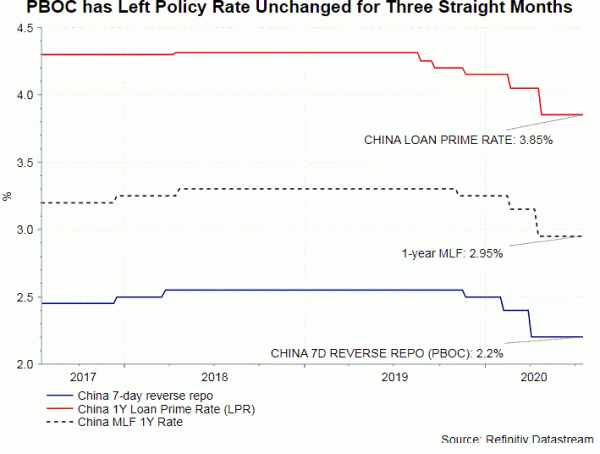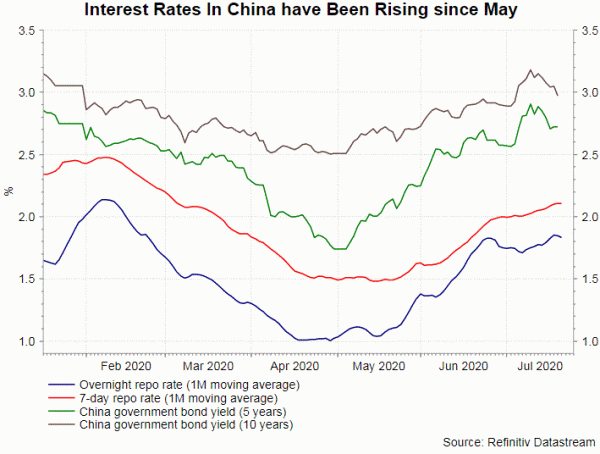PBOC has left the policy rate, the 1-year loan prime rate, at 3.85% in July. The 5-year loan prime rate also stays at 4.65%. The decision has been widely anticipated, as the medium lending facility (MLF) rate, the guidance rate for the LPR, was also kept unchanged at 2.95% earlier this month. The central bank has kept the policy rate unchanged since May, raising speculations that it has done with the easing cycle. Despite the V-shape economic recovery, we expect PBOC to maintain an easing stance in its monetary policy, though future RRR and rate cuts will be targeted ones.
 Rising yields, ambiguous comments from officials and economic recovery have raised speculations that China has done with the easing cycle. The government has affirmed that the monetary policy should be “prudent” and “flexible”. These references usually link to more accommodative policy of PBOC. Meanwhile, some officials have indicated that the current cycle is different from the one in 2008/09 and that excessive stimulus should be avoided. These comments have sent a signal that the easing cycle is coming to an end. Meanwhile, interest rates have been climbing higher since May. The overnight repo rate and 7-day repo rate have risen to the highest levels since mid-February and early March respectively. Yet, little has been done by the government to lower the funding costs.
Rising yields, ambiguous comments from officials and economic recovery have raised speculations that China has done with the easing cycle. The government has affirmed that the monetary policy should be “prudent” and “flexible”. These references usually link to more accommodative policy of PBOC. Meanwhile, some officials have indicated that the current cycle is different from the one in 2008/09 and that excessive stimulus should be avoided. These comments have sent a signal that the easing cycle is coming to an end. Meanwhile, interest rates have been climbing higher since May. The overnight repo rate and 7-day repo rate have risen to the highest levels since mid-February and early March respectively. Yet, little has been done by the government to lower the funding costs.
Adding to the speculations is the encouraging economic developments of late. As we discussed last week, GDP expanded +3.2% y/y in 2Q20, beating consensus of +2.4%. Separately, industrial production (IP) rose +4.8% y/y in June, in line with expectations and accelerating from +4.4% in May. Urban fixed asset investment (FAI) declined -3.1% y/y in the first half of the year, compared with consensus of -3.3%. Retail sales contracted -1.8% y/y, following a -2.8% decline in May. The market had anticipated a mild expansion of +0.5%. On inflation, headline CPI improved further to +2.5% y/y in June, from +2.4% a month ago. While staying in the negative territory, PPI improved to -3% y/y in June, up from -3.7% a month ago.
We do not think that recent economic recovery is putting a brake on PBOC’s monetary easing. Despite the headline readings, China’s recovery is uneven. Growth has been led by infrastructure, real estate and manufacturing activity, while household consumption has been lagging the recovery. This phenomenon will continue for the rest of the year, making credit stimulus an essential part of economic support. Meanwhile, although inflation has shown signs of improvement, it would not be strong enough to derail PBOC’s easing stance. with food price being the key driver of headline CPI, its normalization after flooding and recovery of pork supply after the swine flu shock cause moderation in inflation.
Going forward, we expect China’s accommodative monetary policy will continue. However, rather than adopting broad-based easing, cuts in RRR and interest rates will be targeted to reduce the risk of spillovers to financial excesses. For instance, PBOC lowered the re-lending rate for micro-SMEs and the agricultural sector by 25 bps on July 1. the 3-month, 6-month and 1-year lending rates were reduced to 1.95%, 2.15% and 2.25% respectively. Separately, PBOC also cut the rediscount rate by 25 bps to 2%. The cuts aimed at motivating commercial banks to lend to small firms and the agricultural sector.














